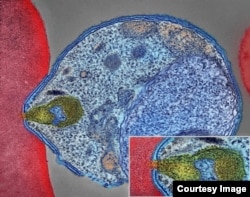Researchers have identified an "Achilles heel" in the malaria parasite — a weakness that could stop the mosquito-borne infection in its tracks. The discovery offers the possibility of a cure, as well as a way to halt transmission.
The malaria parasite, Plasmodium falciparum, uses a protein to infect red blood cells. By blocking the protein, called PfAP2-I, the malaria parasite can't enter the cells where it replicates billions of times before bursting forth into the bloodstream, according to researchers.
The hallmark symptoms of malaria, including high fever and chills, come in waves every 48 hours — which is every time the parasite reproduces.
Halting the so-called invasion phase, according to lead researcher Manuel Llinas, could potentially stop the infection.
"Invasion has for a long time been considered … one of the key parasite-specific processes that, if inhibited, would then prevent the full-blown, massive infections that one normally gets," Llinas said.
Llinas and his colleagues at Pennsylvania State University have identified and characterized PfAP2-I, finding that it regulates more than 150 parasitic genes — nearly 20 percent of which are known to be involved in red cell invasion.
The protein appears to hold the key to activating those parasitic genes, allowing them to gain a foothold during a critical stage of infection.
"It's like we're taking a step back and looking at what actually establishes that program in the first place, preventing any of those molecules from being made in the first place," said Llinas. "And that's really I think the Achilles heel to getting at preventing invasion and stopping the disease altogether."
The findings are reported in the journal Cell Host and Microbe.
For the past 50 years, Llinas said, researchers have been trying to find a way to attack the invasion phase, typically with vaccines aimed at harnessing the immune system.
Because the parasite has dozens of mechanisms to pull itself into red cells after attaching to their surface, it is hard raise an immune response to block them all, according to Llinas.
P. falciparum has also shown resistance to virtually all malaria drugs.
Llinas said the next step is to develop a drug that targets the parasitic protein.
In addition to a possible cure, an agent that targets PfAP2-I has the potential to break the transmission cycle, since there would few, if any, daughter parasites in the bloodstream to infect biting mosquitoes.
There are an estimated 212 million cases of malaria each year, and the disease kills 429,000 people, most of them young children in sub-Saharan Africa.








